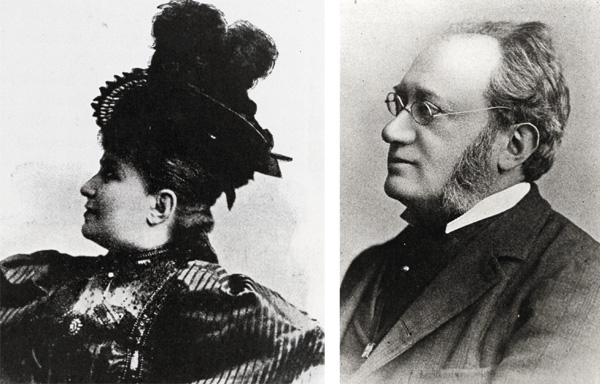Not much ‘Sunshine’ in stormy Sonneschein marriage
Published October 19, 2011
If there had been a local Jewish version of the National Enquirer in St. Louis back in the 1860s, the tabloid would no doubt have devoted oceans of ink to Rabbi Solomon Hirsch Sonneschein and his wife, Rosa Fassel Sonneschein, who can truly be described as the rabbinic “Odd Couple” of the 19th Century.
My late and beloved history teacher from University City High School, Walter Ehrlich, devotes considerable space to the couple. Rabbi Sonneschein was the first rabbi of two St. Louis congregations: first at Congregation Shaare Emeth and then Temple Israel. And Rosa Sonneschein was a highly accomplished woman in her own right: She was publisher of one of the first national magazines for Jewish women and one of only four women delegates to attend the first World Zionist Congress in Basel, Switzerland in 1897.
Ehrlich writes in “Zion in the Valley, Vol. I” of the couple’s early years in Hungary. “Virtually forced by her father to marry Sonneschein (Rosa considered him the least desirable of three prospective husbands her father proffered), the newlyweds were about as incompatible as two young people could be. The marriage proved to be discordant and tempestuous from the very beginning.”
Ehrlich, always the gentleman historian, is unusually blunt in characterizing the Sonnescheins. “Although the Sonnescheins raised four children before they divorced, their lives took distinctively different directions: he was a hard-drinking, crude, firebrand, radical Reform theologian, whose peers would accuse him of being more Unitarian than a Jew; she was a beautiful, avant garde, cigar-smoking feminist, writer and publisher, much happier in a cosmopolitan salon than in a synagogue.”
Like most 19th Reform Jews, Rabbi Sonneschein was anti-Zionist, and so naturally, Rosa Sonneschein became an ardent and enthusiastic Zionist supporter of Theodor Herzl and Max Nordau.
Ehrlich mentions that Rosa’s grandson, David Loth, recalled in a memoir the impact his grandmother had on the St. Louis scene.” He noted that Rosa would appear wearing the latest Paris or Vienna fashions “gracefully,” in contrast to her husband’s austere demeanor. St. Louis Jews “were shocked to observe that she powdered her face, and were scandalized when she attended the theater in the company of the congregation’s most eligible bachelor on a Friday night,” and by the fact that “Rosa maintained her supply of the latest fashions and her contact with the cosmopolitan society of her girlhood by annual trips to Europe,” Jewish Enquring Minds Want to Know: “Who was the hunky bachelor spotted at the Lou’s Symphony with Rosa, the Rabbi’s Wife – on a FRIDAY NIGHT?
It seems that the statute of limitations on not engaging in anything resembling lashon hara (the evil, gossiping tongue) towards a rabbi and his wife expires in about 100 years!
But it would unfair to reduce the Solomon and Rosa relationship and their respective careers to mere scandalous footnotes. Rabbi Sonneschein was the first spiritual leader of not just one, but two of the most enduring Reform congregations in St. Louis: Congregation Shaare Emeth, and Temple Israel. After serving in a New York City congregation, Rabbi Sonneschein accepted the pulpit at Shaare Emeth and served there from 1868 until 1889, when his attendance at a Unitarian retreat caused consternation among members of the Shaare Emeth board, who questioned why a Jewish rabbi would do such a thing. Rabbi Sonneschein protested that he saw his calling as “not only serving a congregation, but generally serving God.” The board’s reply was that the rabbi could “go serve God somewhere else.” As a result of his termination, Rabbi Sonneschein and his loyalists among Shaare Emeth, organized a new Reform synagogue, Temple Israel, continuing a pattern of one congregation “begetting” another, such as when a group of defectors from B’nai El organized Shaare Emeth. Meanwhile, there was much more to Rosa Sonneschein than a beautiful face, big hats and the whirl of high society. In her own right, her career was quite remarkable. A gifted writer and a natural journalist, Rosa founded The American Jewess, described by historian David Geffen as “the first American Jewish women’s magazine.” The publication rose to a national circulation of 29,000. On her own initiative, Rosa wrote to Zionist founders Theodor Herzl and Max Nordau, offering to provide in-depth coverage of the first World Zionist Congress in Basel, Switzerland in 1897. Herzl, as a young Viennese journalist in 1894, had covered the trial of French Jewish Army Capt. Alfred Dreyfus on false charges of treason which brought out raw anti-Semitism among the Paris mobs in front of the courthouse. That experience prompted Herzl to come up with the idea that only a modern Jewish nation-state could assure Jewish survival in an increasingly anti-Semitic world, especially Europe. Herzl admired the passionate zeal for Zionism by the young woman journalist and named Rosa and three other women as non-voting but official delegates to the World Zionist Congress. Writing for her own magazine, and later in a retrospective in the St. Louis Jewish newspaper The Modern View, Rosa, true to her feminist ideals complained about the “antiquated laws relating to women,” expressing regret that she and her female colleagues were “disenfranchised.” Geffen adds, “Fortunately the disenfranchisement vote did not stop Herzl from placing pictures of all the women present on the official delegates photograph.”
Sure enough. When I was in Basel, Switzerland a number of years ago, I visited the King’s Hotel in the city, where Herzl had stayed during the World Zionist Congress. At a small Zionist museum nearby, there is a montage photograph of the delegates to the Congress. Rosa is the one with the big hat.
‘Cohnipedia’ is the ongoing online feature by Editor-in-Chief Emeritus Robert A. Cohn, chronicling St. Louis’ Jewish history. Visit Cohnipedia online at www.stljewishlight.com/cohn
















